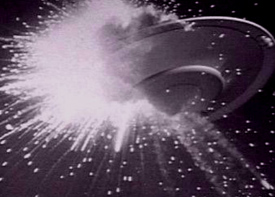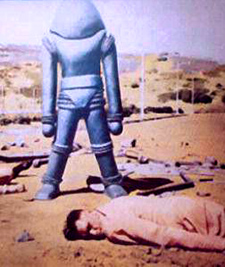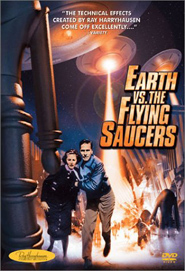| Release List | Reviews | Price Search | Shop | Newsletter | Forum | DVD Giveaways | Blu-Ray/ HD DVD | Advertise |
| Reviews & Columns |
|
Reviews DVD TV on DVD Blu-ray International DVDs Theatrical Reviews by Studio Video Games Features Collector Series DVDs Easter Egg Database Interviews DVD Talk TV DVD Talk Radio Feature Articles Columns Anime Talk DVD Savant HD Talk Horror DVDs Silent DVD
|
DVD Talk Forum |
|
|
| Resources |
|
DVD Price Search Customer Service #'s RCE Info Links |
|
Columns
|
 |
Earth VS. THE Flying Saucers
|
||||
Ray Harryhausen's second outing with producer Charles H. Schneer is an ambitious project that stretched the animator's talents beyond rampaging monsters to create an armada of invading interplanetary spaceships. Naive, rather stiffly directed, this all-out invasion film's outsized thrills made it one of the most popular science fiction attractions of the 1950s.
As dead serious about its interplanetary menace as It Came from Beneath the Sea was about a mighty mollusk from the deep, Earth vs. the Flying Saucers was a matinee gold mine whose title told all. It didn't take long for word of mouth to let the kids know that this one was a keeper. Nervously spinning saucers with saw blade sound effects and jazzy disintegration rays were all over this picture, blasting planes out of the sky, kidnapping Earthmen and making good on their threats in scenes of aerial combat and mass destruction. In sheer scale and screen time, this programmer outdid the much more lavish, Technicolor War of the Worlds. Ray Harryhausen was still on the sci-fi treadmill, establishing his market credentials with producing partner Charles H. Schneer, here still under the schlocky guidance of Columbia cheapskate Sam Katzman. Harryhausen's greater ambitions were in larger-scale fantasy films with mythological beasts, but as outer space and atomic monsters were the rage in 1956, his fine animation skills were used to give life and personality to flying machines, mechanical contraptions with a different set of technical challenges. His saucers scream as they accelerate. A part of their outer rim spins madly, a troublesome animation chore that lends nervousness to their mechanical menace and imparts a gyroscopic, Frisbee logic to their levitation. By carefully choosing stock footage, Harryhausen was able to create some pretty amazing illusions. Test rockets explode harmlessly into the saucers and real footage of airplanes (drones?) disintegrate when hit by animated saucer rays. Of course, destroying identifiable landmarks was as necessary for movie monsters as it was for Alfred Hitchcock, and several highly detailed models of Washington, D.C. buildings and monuments were used for the eye-popping finale. Kids accustomed to getting one or two 'neato' effects per matinee were shown a veritable smorgasbord of destruction, as marble columns and hallowed domes crumbled onto helpless citizens. The key compliment to Harryhausen's visualization is that it is his saucers, not The Day the Earth Stood Still's glowing pie plate or The Mysterians' nifty flying eyes that have persisted as the iconic Unidentified Flying Objects of the 1950s. When Tim Burton unleashed his invasion comedy spectacle Mars Attacks he copied these saucers and even parodied Harryhausen's great set pieces, like the spectacle of the Washington Monument crashing down on terrorized victims.  I don't know how kids or adults who catch up with Earth vs. the Flying Saucers at this late date will react to it. Digital effects do the kinds of tricks seen here so much better, that maybe what was once awe-inspiring is now just silly. But digital effects don't guarantee perfection; the occasional mismatched perspectives or jarring jumps in apparent scale seen here can also be found in many prestigious new films. Harryhausen fans don't need lectures, but others might be more appreciative if they understand that Ray worked practically alone with found materials, and that his zowie effects probably cost no more than the utter garbage seen in a turkey like The Giant Claw. Resourcefulness helped too, when Harryhausen recycled old Republic stock shots of exploding miniature buildings, adding to them his sizzling saucer rays. Story-wise, Earth vs. the Flying Saucers gets an "A" for action and a "D" for detail. The authorities are slow to understand the significance of the saucers' evil intentions (there's not much effort at negotiation here!) and are soon standing with their hands in their pockets, egging on the resourceful Dr. Marvin (or, "Do-oc-k-t-e-r-r Ma-ahr-r-r-v-i-i-n, as spoken by Paul Frees' warbling alien voice). In response, Marvin comes up with anti-saucer weapons faster than a magician can pull rabbits out of a hat. Chief of Staff Thomas Browne Henry notes they only have 9 days to save the world, and circles the number '9' on a cheap printed stationary pad that reads, 'From the Desk of ... Chief of Staff!" The action is rushed, with lines and situations lifted practically verbatim from This Island Earth: "What a beautiful planet. / Thank God it's still here." Hugh Marlowe is a strange choice of hero, considering his earlier role as the hissable villain of The Day the Earth Stood Still. He has a flat delivery and a perpetual grump act going, and is the least imaginative, most military-minded Sci-Fi scientist of the 50s. Of course, we could have had Richard Carlson babbling wondrous Ray Bradbury happy-speak about the aliens ... After their honeymoon in the entrails of the rocket plant boiler room is spoiled, Marvin doggedly makes contact with the alien pirates on a lonely beach (nice scene) and soon relocates his lab to a mountain retreat. Joan Taylor (soon to come back for more humiliation in 20 Million Miles to Earth) lends the show a fair amount of tension, and good old Morris Ankrum has a nice bit as the general given a plexiglass skull by the nefarious saucer men. Where the picture breaks down is in the live action filming of dullsville director Fred F. Sears, who manages to rob the scenes with the helmeted saucermen of their potential thrills. In stills, especially posed ones as in the lobby cards (pictured here) the bulbous, silver saucer dudes look great. They have ray guns in place of hands, and go about their business in sinister little groups. 
But the film spends more time with Marlowe pontificating on the miracles of their sense amplifying helmets (a scene that smacks of a War of the Worlds rip-off) than with the saucer men themselves. It stages most of their action rather stiffly, in particular when one of them is gunned down. Because of this, the invaders remain rather inert ... and make the saucers themselves seem that much more alive. 1 There's a heap of stock footage in this show - from The Day the Earth Stood Still come textless title shots of planets and stars in space, outtakes of people running from the baseball field, and even a shot of the collected scientists from the famous conclusion. War of the Worlds is represented by shots of pileups on freeways and the famous angle of L.A. City Hall being blown to bits. Sam Katzman was an equal opportunity stock library pillager. The second unit work at the end is a real letdown. Limited location angles are padded with shots of the same rather pitiful-looking 'interference ray' trucks driving through what look like Hollywood residential back lots. The juxtaposition of the truck-mounted rays with the saucers going haywire works nicely, but the editor in Savant still wants to cut the sequence down to its thrilling essentials. When the heroes climb under a truck for the last, big explosion, they really seem unconnected to the main action. But the saucer thrills knocked 'em dead in 1956, and is still a heap of fun now. Columbia Tristar's DVD of Earth vs. the Flying Saucers is a pretty-good looking disc. Only one format is encoded, a matted 16:9 widescreen version that is appropriate to what was shown on 1956 screens. Since many fans are used to seeing the film unmatted, they might be alarmed to see the extreme tops and bottoms of shots cropped away. The framing is a bit suspect, as the titles are so far off center as to make the left extreme of some of the credits go off screen. Otherwise, the show looks good: Sharp, reasonably clean. The only detriment is some riding on the cuts, probably the result of old splices going through the telecine. Columbia has added yet again the Richard Shickel documentary, which is fine but rather overexposed by now, along with the trailer short subject This is Dynamation! But making up for the repetition is the inclusion of a nifty Ray Harryhausen interview conducted by amiable director Joe Dante. Ray looks in fine fettle and together they handle a saucer animation model (it's pretty darn small!) and discuss the finer points of flying saucer movies. A component of the film's flying saucer sound effect was found when producer Schneer heard the sound of effluent (polite word) being pumped through the giant pipes in the sewage treatment plant that serves as the Rocket Base set in the movie. The attractively designed package tries but doesn't quite best the original poster artwork; the menu also has a gallery of stills and posters for the popular picture.
On a scale of Excellent, Good, Fair, and Poor,
Earth vs. the Flying Saucers rates:
Footnote:
1. A note for Harryhausen detail maniacs - there's a toy model of a
'woody' station wagon that can be seen in at least 2, and maybe three tabletop effects angles in
this show. It was used repeatedly in all of Ray's B&W films since The Beast from
20,000 Fathoms.
Review Staff | About DVD Talk | Newsletter Subscribe | Join DVD Talk Forum |
|
| Release List | Reviews | Price Search | Shop | SUBSCRIBE | Forum | DVD Giveaways | Blu-Ray/ HD DVD | Advertise |






